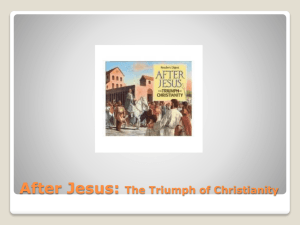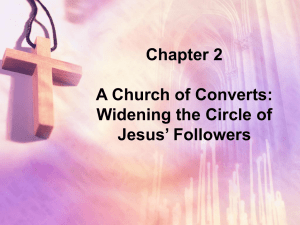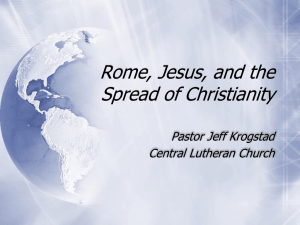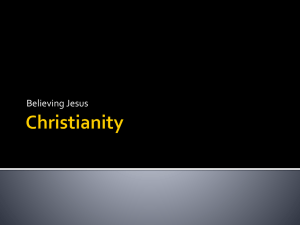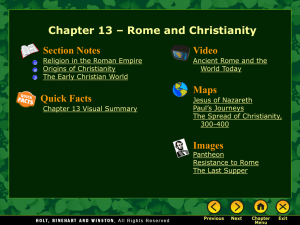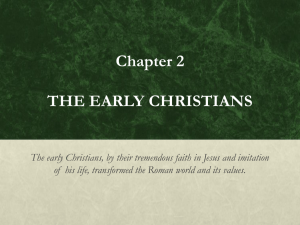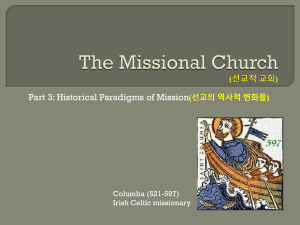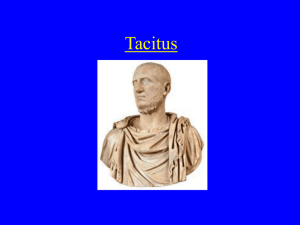After_Jesus.10991722.. - First Baptist Church of Madison
advertisement
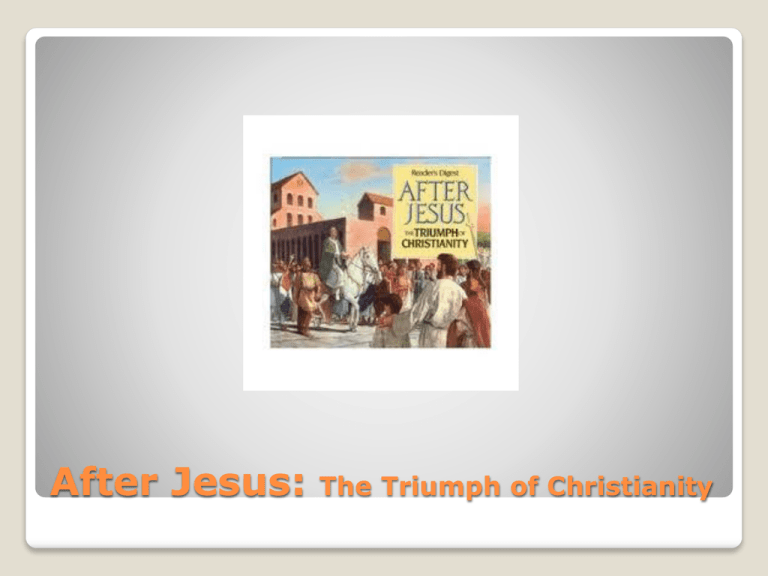
After Jesus: The Triumph of Christianity Based on the book of the same title by Jane R. Baun; Rita G. Christopher; Donald R. Cutler; Marleen B. Flory; Charles Flowers; Robert Kiener; Robert Thurston; Edward Watkin; Peter Young Gayla Visali – Editor Published by Reader’s Digest, 1992. On the day of Pentecost, after Jesus’ death, his disciples were suddenly filled with the Holy Spirit and began to speak excitedly about the works of God. Strangely, their ecstatic words were heard not as a Galilean dialect of Aramaic (their native language) but as all the languages spoken by the pilgrims visiting Jerusalem. Part I: In Jesus’ Footsteps (A.D. 30-40) Jesus, it is recorded in the gospels spoke of his death and gave it meaning in celebration of the Passover meal called the Seder. Along with baptism the Lord’s Supper (Communion) have been unbroken rituals throughout Christian tradition. The Last Supper Jesus died by the brutal capital punishment inflicted by the Romans. The early followers were destroyed, but would later come to view his death as integral to their salvation and in fulfillment of ancient Hebrew prophecy (Isaiah 53). The Crucifixion Prior to his death, according to the gospels, Jesus predicted his death and resurrection. This event will define the church as believers in the Resurrection. The Resurrection was the physical raising of Jesus from the dead. The circumstances of his death and reports of his rising were public and well known. The Resurrection Hundreds of people saw the risen Jesus. A few of these encounters are recorded in the gospels. On the road to Emmaus two travelers walked with Jesus but did not recognize him until they broke bread together. Jesus’ appears to many of his followers As the disciples waited and prayed they were baptized in the Holy Spirit. Tongues of fire rested over their heads and they were commissioned to go into all the world with the good news of the Resurrected Jesus. “I will pour out my Spirit.” Peter who had previously denied he knew Jesus now with the power of the Holy Spirit filling his soul preached courageously and effectively to the masses gathered in Jerusalem. The first proclamation of the gospel The church was born in the City of Jerusalem. It is important in Hebrew history and the center of the importance is the Temple which Jesus claimed himself to be the fulfilment of its purpose. Jerusalem Emperor Hadrian and the Savior god Serapis represented on the coins were just two aspects of the plurality of religions and cultures into which the new faith in Christ emerged. In addition to GrecoRoman religions there was also oriental, Egyptian, and sects of Judaism influencing the new faith. Competing faiths and cultures Within five year’s after Jesus’ death a church had been established in Jerusalem and missions sent out. Religious life centered around three functions: Prayer (the Lord’s Prayer recited). Sermons and Teaching A Daily Common Meal (The Lord’s Supper) The meal fed hungry Christians as well. Early Christian Lifestyle To provide sustenance for poorer converts and for preachers early Christians shared their possessions. It was the practice of the early church to help the poor especially widows. When the Hellenist Christians complained that their widows were being neglected deacons were chosen. More than just social service, they were also active in missions. Everything in common A dramatic ritual connected with conversion. Involved a confession of faith followed by complete immersion in water in the name of Jesus Christ. Variations on immersion were created by end of the first century (water poured 3xs over the candidate’s head). Christian baptism was meant to be a single stirring event. Baptism “Followers of the Way” “The Way” “The Way of the Lord” “The Way of God” “Nazarenes” – derisive N.T. : “God’s temple” “little flock” “salt of the earth” ”church”-ekklesia in Greek “Christian” – 40 A.D. Names for Christians The strongest opponents of early Christianity were the Sadducees. Joined in opposition by the Pharisees. Elders of both groups sat on the Sanhedrin. The opposition A heated debate resulted in violence when Hellenist Jews became outraged at Stephen and rushed him before the Sanhedrin. The first follower of Christ to die for the profession of his faith. He is stoned by an angry religious mob. Assisting in the action was a young Pharisee from Tarsus named Saul. Martyrdom of Stephen Saul of Tarsus, a member of the party of the Pharisees became an ardent persecutor of the young church. On his way to Damascus he is struck blind, confronted by a heavenly voice, and converted. The Christians in Damascus eventually accept him, though they were at first doubtful. Paul’s conversion Jesus’ disciples and followers recalled his deeds and words. The oldest gospel (good news) is the account given by Mark. Other accounts include the synoptic (same eye) gospels of Matthew and Luke. The final gospel is that of John. Recollections of Jesus As “the Way” moved from Jerusalem to Antioch and on to Rome, Gentiles joined the ranks, ministered to especially by Paul, the converted Pharisee. Meanwhile, Rome was ravaged by a devastating fire, and tensions in Jerusalem were building toward a disastrous conflict with the Roman Empire. Part II: A Tale of Three Cities (A.D. 40-70) To bring Gentiles into the Christian community was not an easy step. Jews were forbidden to eat with them or consume food apart from the dietary laws. Only a pagan who had converted to Judaism, agreeing to live by its laws, would be able to take the next step and be baptized in Jesus’ name. While praying on the roof of Simon the tanner Peter has a vision that changes the church. Breaking the bread with Gentiles The Ethiopian eunuch like Simon the tanner would have been unclean but instead was baptized on the spot by Philip. Conversion of a eunuch They rejected belief in pagan gods and magic; adopted the Christian ethic, which besides avoidance of sins such as idolatry and adultery, stressed charity and brotherhood. They were now part of a loving community that took care of one another in time of illness and other troubles, even meeting needs for basic food and shelter if necessary as well as a strong belief in life after death. What it meant to become a Christian They met in homes. Paul writes, “When you come together, each has a hymn, a lesson, a revelation, a tongue, or an interpretation. Let all things be done for edification.” It is clear that these early gatherings were dynamic and exciting and encouraged every worshiper to participate. Christian meetings It was at Antioch the followers of the Way were first called “Christians.” Antioch’s church attracted all classes from patrician to slave. It counted wealthier citizens among membership. From 46 AD the community sent famine relief to Jerusalem. It was from here that Paul and Barnabas departed on their missionary journey. Antioch, a first outpost Jerusalem was still headquarters of the movement. The group that remained after many had fled the persecutions led the Jerusalem church down a more conservative road. James , the leader of the church acted as mediator between those powerful Jewish Christians who were opposed to welcoming Gentiles and those who were willing to receive them. The church in Jerusalem Thanks to Caligula (37-41) relations between Rome and the Jews became more hostile. He became obsessed with the idea that he was a living god. When opposed he demanded that a colossal golden statue of himself be erected at the Temple in Jerusalem. He was assassinated before the order could be carried out, but the damage was irreparable. An insane emperor He covered some 10,000 miles over his lifetime. He suffered shipwrecks, a stoning, beatings, imprisonments, humiliations, the rigors of primitive travelling conditions, and a great deal more in his mission to spread the word of Christ. His capacity for survival was coupled with an ability to touch people’s souls as he preached the Gospel. Paul’s missions How did Christianity’s most successful missionary survive such hardships? His devotion to spreading the gospel apparently strengthened his nerve. He planned his travel carefully following Roman highways and sea routes. At times his Roman citizenship helped him, as did his knowledge of Greek, and skill as a tentmaker. On the road again Paul would realize his dream of journeying to Rome. After his fourth shipwreck in Malta he was finally transported to Puetoli and then to Rome. He was placed under house arrest for two years and welcomed all who came to him. It is possible that he travelled all the way to Spain (Clement of Rome). All roads lead to Rome Possibly began by Jews after they returned from pilgrimages to Jerusalem in 40’s, and possibly 30’s. Claudius (41-54) expelled the Jews “ because they caused continuous disturbances at the instigation of Chrestus he expelled them from the city.” Aquila and Pricilla were among these. They went to Corinth. The Christian community in Rome A typical Roman believed that gods controlled nearly every activity in the world and that paying them homage to them would guarantee success or at least stave off disaster. Moral codes were determined more by social or familial codes of behavior. The father or paterfamilias dominated. He could decide life or death within his family. Pagan life There continues to be speculation as to whether or not Peter actually went to Rome, much less was the head of the Roman church. Archaeology in the Vatican seems to point to the grave and bones of Peter buried beneath St. Peter’s Basilica. Peter in Rome July 19, 64 AD a fire began near the Circus Maximus spread by the wind and ravaged the city. The fire burned for nine days and left most of the cit y in ruins. Thousands lost their lives and the streets were filled with distraught, displaced persons. As Rome burned Although Nero had rushed to his subjects aid, a rumor quickly circulated that he was the cause of the fire. According to Tacitus, “to suppress this rumor, Nero fabricated scapegoats – and punished with every refinement the notoriously depraved Christians (as they were popularly called).” Scapegoats found Handsome and headstrong, he ordered his own mother’s death, vain and a lover of arts and entertainment, he admired all things Greek. He was a tyrant, claiming to be equal with Apollo. A great persecutor of Christians. At his death the Empire was in deep turmoil which would soon burst into war in Judea. The pleasure-loving Nero In 66 AD in response to a pagan sacrifice that was deliberately made in front of a synagogue in Caesarea, a delegation of Jews protested. The governor had them arrested and then took money from the Temple treasury. Then he ordered Roman troops to raid the markets in Jerusalem killing 3,600 men, women, and children. The Jewish War Herod Agrippa II sent 2,000 troops to assist the rebels. By late summer the rebels had taken control of Jerusalem. The crack 12th Legion was sent down from Syria. The Jews managed to hold off the Romans and forced them to retreat. Nero dispatched Vespasian to quell the rebellion with three legions. His son Titus prevailed with 80,000 troops. Rebel successes Some perished, some fled, and some returned. But Jerusalem was no longer the nucleus of the church. Jews supporting the revolt would have seen Christians (who remained neutral) as betrayers. Rabbis added to the synagogue liturgy a prayer that condemned Jewish Christians. From then on Christianity would develop separately from Judaism. What happened to the Christians? Most scholars think the Gospel of Mark was composed around 70 AD. The claim of 70 is based on Mark’s description of the destruction of the Temple, as prophesied by Jesus. Considered the earliest Gospel, Mark apparently was used for Matthew and Luke. Others, including your pastor) challenge this date believing the authorship is earlier. Mark’s Gospel As Christianity passed the half-century mark, the churches organized to meet new challenges. The scriptures are produced. Heirs Of Jesus Christ The Roman church grew quickly (70 AD). By the end of the first century the congregation had adopted a leadership role throughout the empire. The claim that both Peter and Paul had died there added weight to this claim . The Roman church also prospered enough to send contributions to other churches. Christianity in Rome Vesuvius formed a time capsule of first century Roman life. Pompeii 70 A.D. Rome is in shambles following the rule of Nero. Suetonius noted, “Throughout his reign he made it his principal business to shore up the moral foundations of the state, which were in a state of collapse.” Vespasian rebuilds Rome By the end of the first century A.D. the Apostles had taken the gospel north into Syria and Asia Minor; west to Macedonia, Greece, Italy, and the isles of the Mediterranean; then to northeastern Africa, and Egypt. A century later Christian communities existed in Gaul (France), Germany, and the Iberian Peninsula (Spain) as well as in northwestern Africa. The Spread of Early Christianity A well respected ruler who continued many of his father’s policies. Titus Domitian considered himself the guardian of the people’s morals, and in 85 CE he appointed himself censor for life, with a general supervision of conduct and morals. Although Domitian’s conduct did not always reflect good personal conduct and moral behavior, he was a big supporter of traditional Roman religion; he also seemed to hold Minerva and Jupiter in the highest esteem. Domitian And on the day called Sunday, all who live in cities or in the country gather together to one place, and the memoirs of the apostles or the writings of the prophets are read, as long as time permits; then, when the reader has ceased, the president verbally instructs, and exhorts to the imitation of these good things. Then we all rise together and pray, and, as we before said, when our prayer is ended, bread and wine and water are brought, and the president in like manner offers prayers and thanksgivings, according to his ability, and the people assent, saying Amen; and there is a distribution to each, and a participation of that over which thanks have been given, and to those who are absent a portion is sent by the deacons. • Justin Martyr, First Apology c. 150 AD Early Christian Worship Paul mentions no ecclesiastical hierarchy when he wrote to Rome in 50 A.D. In Clement’s letter to Corinth near the end of the first century, it says just as Christ commissioned Apostles, so the Apostles had in turn “appointed … bishops (overseers) and deacons (ministers) for those who should afterward believe.” Also bishops refers to presbyters or elders. Early Christian Leadership

